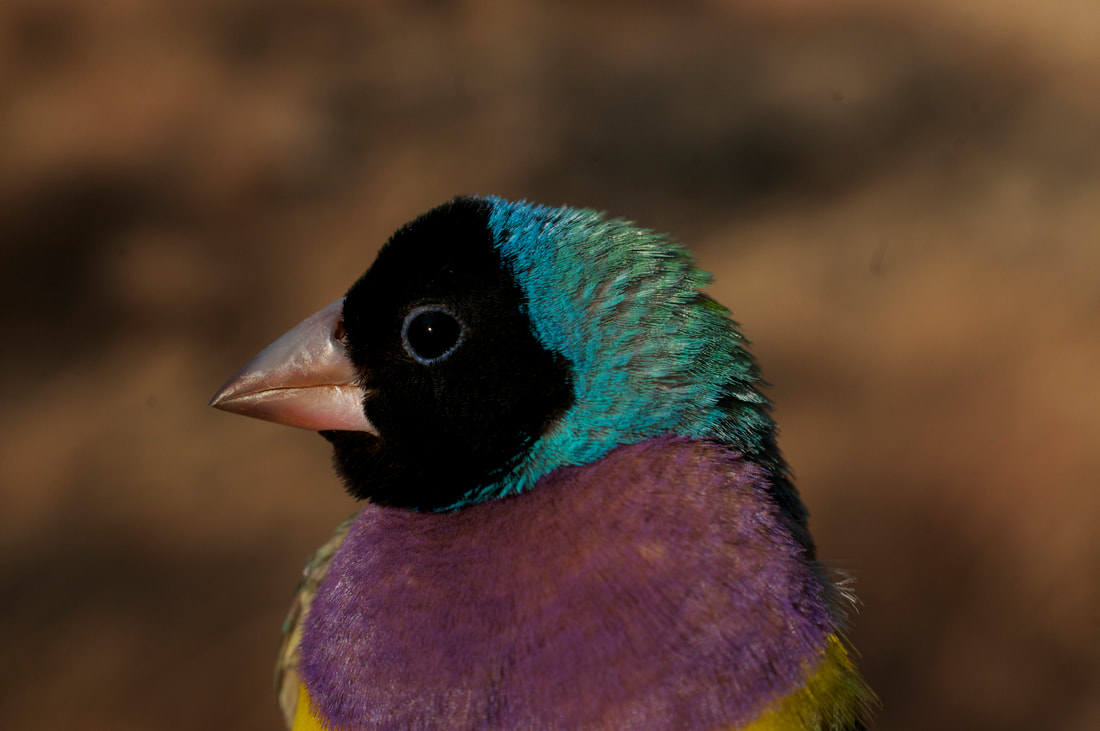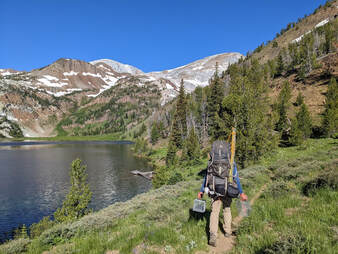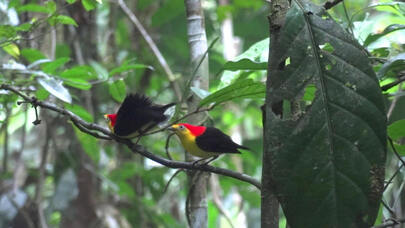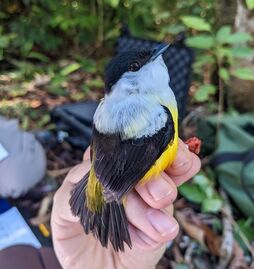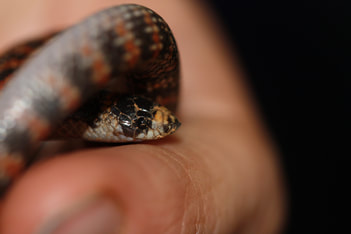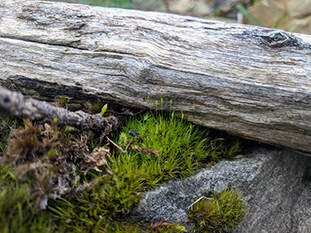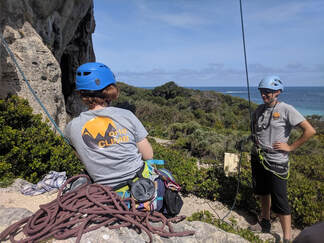Projects & Interests
Broadly, I am interested in linking the ultimate and proximate causes for trait variation using genomic methods. I am interested in how variation is distributed across landscapes, and the genetic architecture and regulatory mechanisms that underpin trait variation. I am particularly empassioned by using these two prongs of evolutionary biology to solve problems in conservation. I am primarily motivated by interesting questions in this space, but I have a special place in my heart for birds and reptiles.
Conservation genetics
|
My PhD research focused on the threatened Gouldian Finch (Chloebia gouldiae), which occurs across the monsoonal savannahs of northern Australia. It has two sympatric red and black head-colour morphs. Previous work on captive birds showed these colour morphs are linked to distinct behavioural and physiological strategies, and there is post-zygotic incompatibilities between morphs. My thesis focused on: 1) Using genetic and genomic techniques to assess population size, structure and demographic history of the Gouldian finch. 2) Exploring the degree of post-zygotic isolation between colour morphs in the wild, and the consequences for conservation.
|
|
During my most recent postdoc I have been collaborating with Dr Chris Balakrishnan and (now Dr!) Dustin Foote of Sylvan Heights Bird Park, NC on the conservation and immunogenomics of Endangered white-winged ducks (Asarcornis scutulata).
In collaboration with Dr Ben Vernasco and funded by the American Ornithological Society, we recently were the first people to catch and release Wallowa rosy-finches for a project on the genomics of this threatened alpine bird. |
Animal Behaviour
|
I am interested in understanding the how (mechanisms) and the why (evolution and ecology) of animal behaviours. Understanding animal behaviour is also critical in species conservation because it influences population processes, disease transmission, and how a species will respond to management interventions.
I primarily use genetic methods to understand social behaviours at the population level, such as through patterns of paternity and relatedness in social structures. In my recent postdoc I started to cut my teeth into the neurogenomic mechanisms of behavior, to provide me with skills to understand mechanisms of adaptive traits more broadly. |
|
Most of this recent postdoc has been focused on Manakins. The Neotropical Manakins (Pipridae) are famous for their cute and colourful lekking displays. Lek displays are typically a solo endeavour, but the males of some manakin species perform coordinated lekking displays with other males.
In this space I've been working on the neurogenomic mechanisms underlying testosterone mediated cooperative display behavior in wire-tailed manakins (Pipra filicauda). This work is in collaboration with Drs Chris Balakrishnan, Ros Dakin, Brent Horton and Brandt Ryder. I've also been lucky to work with Kevin Bennett and Prof Mike Braun at the Smithsonian National Museum of Natural History on hybridsation in Manacus manakins and using camera traps to characterise display variation and mating success. |
Evolution in Captivity
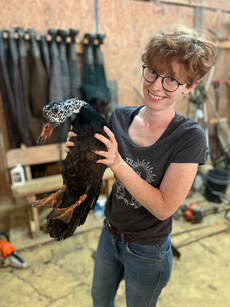 Me before taking blood samples from one of the precious few white-winged ducks at Sylvan Heights Bird Park
Me before taking blood samples from one of the precious few white-winged ducks at Sylvan Heights Bird Park
What draws me to this work is its inherent interdisciplinarity, as it combines evolution, behavior, genetics and management.
Individuals in captivity experience a vastly different environment than their wild cousins, which can result in rapid evolution to the novel environment. Artificial selection plays a role, but also unintentional founder effects and husbandry practices can generate differences between wild and captive organisms. Evolution in captivity is relevant when extrapolating biology of organisms from the laboratory into the wild, and has a practical impact on conservation captive breeding programs.
I am interested in investigating the behavioural and genetic effects of domestication in Australian estrildid finches (primarily the Gouldian finch (Chloebia gouldiae)). Work from my PhD found that the post-zygotic incompatiblity between Gouldian finch colour morphs was absent (or very weak) in wild Gouldian finches. This may suggest the evolution (or intensification) of incompatibility in the domesticated birds. My work is exploring selection occurring in captivity from colour morph frequency to the genomic level.
I am also working with Chris Balakrishnan and (now Dr!) Dustin Foote of Sylvan Heights Bird Park, NC to explore the effects of captivity on the endangered white-winged duck (Asarcornis scutulata). Particularly how its captive management and genetics could explain its punishing susceptibility to avian tuberculosis (Mycobacterium avium subsp. avium). We are using genome resequencing and RNAseq to characterize the overall genomic effects of captivity, and the genetic architecture of TB susceptibility.
Individuals in captivity experience a vastly different environment than their wild cousins, which can result in rapid evolution to the novel environment. Artificial selection plays a role, but also unintentional founder effects and husbandry practices can generate differences between wild and captive organisms. Evolution in captivity is relevant when extrapolating biology of organisms from the laboratory into the wild, and has a practical impact on conservation captive breeding programs.
I am interested in investigating the behavioural and genetic effects of domestication in Australian estrildid finches (primarily the Gouldian finch (Chloebia gouldiae)). Work from my PhD found that the post-zygotic incompatiblity between Gouldian finch colour morphs was absent (or very weak) in wild Gouldian finches. This may suggest the evolution (or intensification) of incompatibility in the domesticated birds. My work is exploring selection occurring in captivity from colour morph frequency to the genomic level.
I am also working with Chris Balakrishnan and (now Dr!) Dustin Foote of Sylvan Heights Bird Park, NC to explore the effects of captivity on the endangered white-winged duck (Asarcornis scutulata). Particularly how its captive management and genetics could explain its punishing susceptibility to avian tuberculosis (Mycobacterium avium subsp. avium). We are using genome resequencing and RNAseq to characterize the overall genomic effects of captivity, and the genetic architecture of TB susceptibility.
Systematics and Taxonomy
|
In 2011, I conducted my Honours year research with Scott Keogh at the Australian National University . The Australian burrowing elapids are an understudied and mysterious group of Australo-Papuan elapids, that live primarily in the Australian arid-zone and wet tropics. They consist of the poorly known genera Simoselaps , Brachyurophis (photo),"Neelaps" and Vermicella. I generated a multilocus phylogeny in order to explore the roles of adaptive divergence and historical climate change in Australia within the burrowing group and the elapids as a whole.
Since then, we have added a lot of new specimens from poorly sampled areas and followed up with some morphology work. |
I spent nearly two years working at the Australian Biological Resources Study, helping to manage the Flora of Australia and led the Bryophytes of Australia eFlora projects.
I worked with Helen Ramsay and John Spence to update the Australian Bryaceae treatment for the Bryophytes of Australia. |
World Climb
|
Combining my interests in conservation and climbing, I am collaborating with WorldClimb (insta: @theworldclimb) to assess the effects of rock climbing on cliff vegetation. This National Geographic funded project aims to assess vegetation growing on climbing cliff faces in mediterranean biomes across the world using a novel survey method.
This project is headed by Dr Martí March-Salas, with Dr Indra deCastro-Arrazola, Dr Natasha Robinson and I coordinating the Australian fieldwork. |
Competitive replacement in the Late Cretaceous dinosaurs
Over summer 2009/2010, I conducted a small research project under the supervison of Matt Phillips.
This project examined complementary mechanisms for dinosaur extinctions prior to the Cretaceous/Paleogene boundary. We used worldwide dinosaur fossil data to document changes in dinosaur composition and ecologies throughout the Cretaceous Period.
This project examined complementary mechanisms for dinosaur extinctions prior to the Cretaceous/Paleogene boundary. We used worldwide dinosaur fossil data to document changes in dinosaur composition and ecologies throughout the Cretaceous Period.
